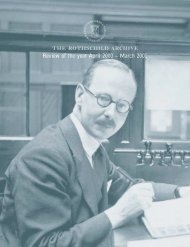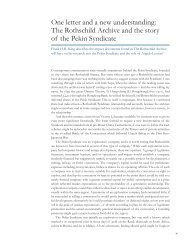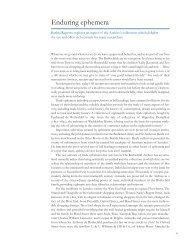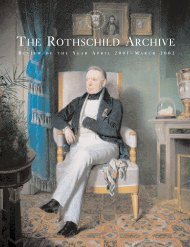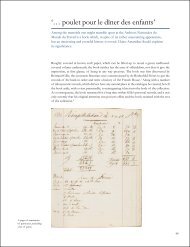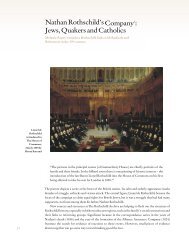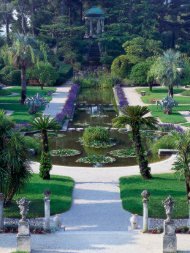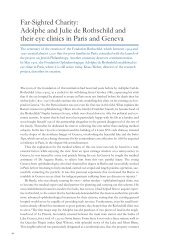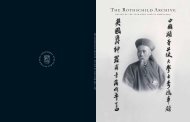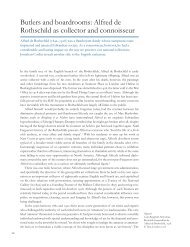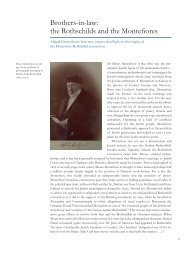66900 Rothschild Archive - The Rothschild Archive.
66900 Rothschild Archive - The Rothschild Archive.
66900 Rothschild Archive - The Rothschild Archive.
Create successful ePaper yourself
Turn your PDF publications into a flip-book with our unique Google optimized e-Paper software.
18<br />
Other images were taken at the older family home at Gunnersbury in west London, where<br />
a favourite time of year was the flowering of the lilies in the lake before the house. But the<br />
gardens of friends, both great and small, were also laid siege to by Lionel’s camera. Close-up<br />
studies of flowers, rural scenes of heath with gorse, the interiors of glass-houses: all were of<br />
interest to him.<br />
In France his cousin Edmond, also a banker, invited him to his home at Boulogne-sur-Seine<br />
outside Paris, where Lionel photographed both the formal gardens and the Japanese Garden. It<br />
seems highly probable that, on one of these visits, he would have met Edmond’s neighbour,<br />
Albert Kahn, another Jewish banker who was then developing his interest in the Autochrome,<br />
an interest which was to lead on to his hugely ambitious twenty-year long project, Les <strong>Archive</strong>s<br />
de la Planète, a massive collection of 42,000 Autochromes and a hundred hours of film,<br />
attempting nothing less than a vast album of images of every corner of the globe. It is impossible<br />
not to believe that their conversation would have turned excitedly upon the Autochrome<br />
and its future.<br />
Some of the most arresting images among Lionel’s work, almost a hundred in number, are<br />
portraits of family and friends, again mostly taken in the setting of family gardens. It is here,<br />
perhaps, as we stare back into the eyes of Edwardian high society, that we most clearly experience<br />
the shock and surprise of seeing in colour a world before the First World War which we<br />
have grown used to thinking of in monochrome. And there is an added poignancy in the images<br />
of smiling faces at an Army encampment in Buckinghamshire in 1910, blissfully unaware of the<br />
onslaught which would come four years later.<br />
Of the rest of Lionel’s Autochromes, some four hundred in number, most were taken on<br />
tours in Europe and North Africa, a clear indication that, for him, as for so many of us, photography<br />
remained largely a holiday habit. As at home, so abroad, the theme of plants and trees<br />
in landscapes recurs again and again, whether in the study of a corner of a Mediterranean garden,<br />
with the sun on a terracotta urn, draped by a curtain of cypresses, or a tree heavy with<br />
oranges against a background of mountains and sea.<br />
But there was also an educational strain to Lionel’s work. Whether in Egypt, Rome or<br />
Pompeii, his eye was drawn, like any other tourist, to the ruins of past civilisations, but his was<br />
an eye tempered by a clear interest in the detail of those long-gone societies. We know from surviving<br />
lecture notes that he prepared at least two sequences of plates to be projected for an<br />
audience. <strong>The</strong> notes betray wide reading in and around his subjects to bring to life the world<br />
whose magnificent vestiges he was capturing in his lens.<br />
Other survivals, less easy to categorise, are relics of Lionel’s bolder attempts to explore the<br />
potential of the Autochrome. A few are still-life compositions, of flowers in a vase with oranges<br />
and books or maize-cobs laid out to dry on a sun-baked stone wall. <strong>The</strong>re are attempts (many<br />
of them brave but unsuccessful) to challenge the technical difficulty of capturing broad sunset<br />
skies at dusk. And there is the fascinating handful of images of animals and birds in the<br />
Zoological Gardens in London, the earliest known colour photographs taken there.<br />
<strong>The</strong> Autochrome, ground-breaking as it was, in the end proved to have drawbacks discouraging<br />
to the amateur. <strong>The</strong> plates could not be printed onto paper and could therefore only be<br />
viewed through a viewer or a projector; it was not possible to copy them, so each image was<br />
unique and irreplaceable; and they were expensive compared with black-and-white plates. By<br />
the time war broke out, interest had waned and the Autochrome survived largely as a format for<br />
the professional. So it was with Lionel. <strong>The</strong> most enthusiastic phase of his interest dates from<br />
the few years between 1908 and 1912, culminating with a splendid series of images of Italy<br />
taken on his honeymoon with his wife Marie-Louise.<br />
After the war, now weighed down with the responsibility of partnership in the bank and<br />
fired with a new passion for developing his horticultural interests on his estate at Exbury in<br />
Hampshire, Lionel confined his photography largely to family groups and holidays – and solely



